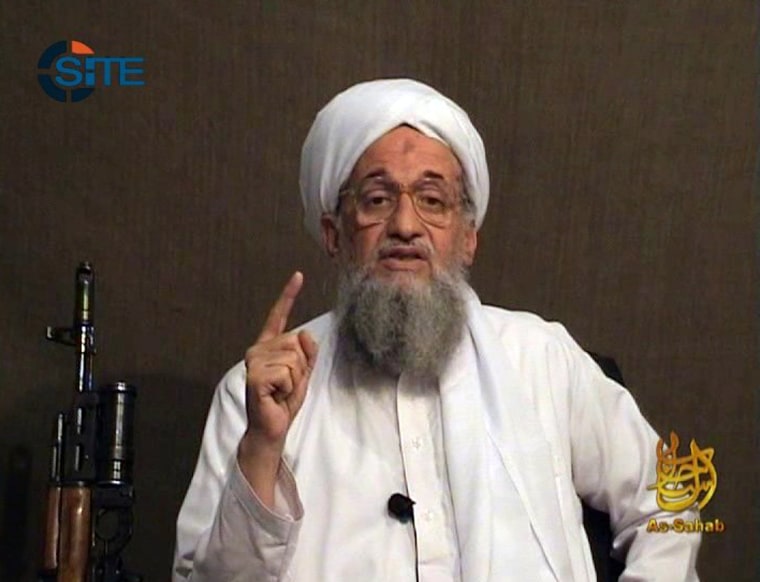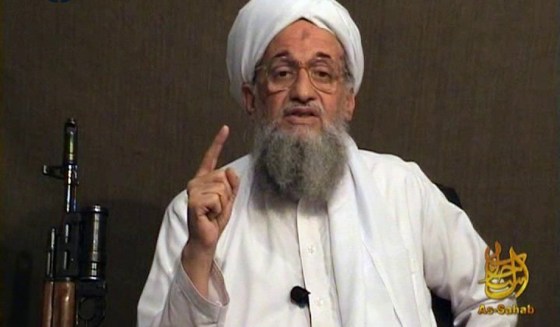Five years after he succeeded Osama bin Laden as leader of al Qaeda, Ayman al-Zawahiri is still not dead. Experts who can’t agree whether he’s a has-been or a mastermind can agree on one thing: he’s very good at hiding.
U.S. intelligence officials, who tracked bin Laden to a Pakistani compound and killed him, won't say if they know where Zawahiri is, but admit the 64-year-old Egyptian physician-turned-radical is elusive.
Zawahiri has survived at least four U.S. assassination attempts. But there have been no close calls since 2007, almost a decade ago.
Zawahiri, say U.S. officials, has gone to extremes to escape U.S. targeting. His security guards have reportedly married into local tribes for protection, and he has used "green screen" technology to disguise his living conditions in video messages. According to various U.S. officials, Zawahiri is believed to be in a remote area along the Pakistani-Afghanistan border.

U.S. officials downplay his current importance, saying he’s an uncharismatic figure who’s been driven deeper and deeper into the wilderness as drones wipe out his henchmen. He’s been eclipsed by ISIS, they say, and reduced to jealous sniping at the Islamist upstarts who have taken over parts of two countries.
Said one U.S. counter-terrorism official, "He is a marginalized figure fighting for relevance as head of a decrepit institution."
Some experts, however, say U.S. intelligence exaggerates al Qaeda's decline.
Thomas Joscelyn, a senior fellow at the Foundation for Defense of Democracy and senior editor of The Long War Journal, says Zawahiri still commands a significant swath of the worldwide jihad.
"Zawahiri is not as out of the game or in as much of a crisis mode as intelligence analysts suggest," said Joscelyn. "A large number of jihadis are still loyal to him.”
Recently, Zawahiri has been dispatching operatives to Syria, and has even formed an apparent alliance with Osama bin Laden’s favorite son. He and Hamza bin Laden, 23, have been coordinating the simultaneous release of audio messages. One U.S. official portrayed Zawahiri’s enlistment of Hamza as “an attempt by AQ to fill gaps in its ever dwindling bench.” But some experts also wonder if Zawahiri is grooming a successor, and rebooting al Qaeda.
Zawahiri, the co-founder of al Qaeda, was crucial to the planning of 9/11 as bin Laden’s second-in-command. And in the months after the attacks, he was the terror group’s most visible face, posting audio and video messages. Then the messages became less frequent — and less significant — as al Qaeda faltered, its leadership decimated by drones and special operations raids.
Zawahiri came close to death at least four times in the first half-dozen years after 9/11. Twice during the siege of Tora Bora in November 2001, he was targeted but survived. One of his wives and two of his children died in one of the attacks.
Then in January 2006, the CIA and Pakistani forces believed they had found him in the Pakistani village of Damadola and launched a volley of Hellfire missiles at him. Eleven jihadis were killed, but Zawahiri quickly released a video message showing he had survived.
In August of 2007, there was another assault on caves in Tora Bora. U.S. intelligence analysts believed strongly that there was a high probability that “either HVT-1 or HVT-2 was there,” using U.S. intelligence descriptions — high value targets — for bin Laden and Zawahiri. Ultimately, even though their attacks left dozens of al Qaeda and Taliban dead, U.S. forces failed to find Bin Laden or Zawahiri.
Less than four years later, Navy SEALs killed bin Laden, and the U.S. continues to degrade the upper ranks of al Qaeda. But Zawahiri lives on.
The numbers show just how alone he’s become. According to an NBC News analysis, of the 10 members of the al Qaeda shura council who approved the 9-11 attacks, Zawahiri is one of just four who haven't been killed or captured. Of the 22 men indicted in the East Africa embassy bombings, he may be the only one who hasn’t been captured, killed or died in captivity. (U.S. officials won’t comment on the fate of two of the men who were captured by Iranian forces after the U.S. invasion of Afghanistan in 2001.)
More telling is that seven possible replacements for bin Laden and Zawahiri have been killed since Zawahiri took over in 2011, the most recent last summer. Nasir al-Wuhayshi, killed June 12, 2015, had just been named Zawahiri's deputy when he was killed in a drone strike. Since then, al Qaeda has not named a replacement, perhaps out of fear he will be targeted as well.
In the five years since he was named bin Laden's successor, Zawahiri has faced crisis after crisis ... and al Qaeda Central is no longer what it once was, says CIA Director John Brennan.
"The core al Qaeda — the group that is now led by Ayman al-Zawahiri — is not what it used to be," Brennan told NBC News last month. "But it did take quite a bit of patience and time and a deliberate and focused years-long effort for us to be able to say that we really have taken off of the battlefield much of al Qaeda’s capabilities."
The big reason may very well be that Zawahiri, more of a theoretician, is not the charismatic figure that Bin Laden was and "never had his mojo," as the counter terrorism official noted. He has, according to U.S. intelligence, a grating, arrogant personality that hurts him and the organization. One senior U.S. intelligence official said that Zawahiri was never fully in sync with al Qaeda thinkers who wanted to globalize the group, and added that his understanding of the dynamics on the ground in Syria are rudimentary.
Indeed, he and the leader of ISIS, Omar al-Baghdadi, are actually engaged in a feud. Zawahiri, author of some of the worst terrorist attacks in history, calls al-Baghdadi and ISIS "extremists."
Just a week ago, in a 10-minute audio message, Zawahiri said ISIS was not a "rightly guided caliphate" and called al-Baghdadi a "caliph of surprises." He once again called on jihadis to support al Qaeda's embattled affiliate, al Nusrah, instead, which he said could bring a "real caliphate" to Syria.
The reaction to Zawahiri's message was muted, with several in U.S. intelligence seeing it as the ravings of a man who had lost "the mantle of jihad," as the counter terrorism official put it.
But whether Zawahiri is a spent force or the "wise man of the ummah," as his followers call him, he has survived. Zawahiri remains at large and able to record and disseminate propaganda.
There’s no indication he has been personally targeted since 2007 — perhaps because he has taken more care. Reports indicate that over the years he moved from Pakistan’s urban areas to built-up areas along the Afghanistan border and then finally north into the mountainous tribal areas of the border region.
Experts say the intermarriage of his entourage into the local tribes provides both Zawahiri and his followers with a greater level of protection.
He has also disguised his whereabouts using imaging technology. In one September 2006 video, Zawahiri was featured in what appeared to be a library, complete with a desk, a banner, a bookshelf and even a toy cannon mounted on the bookshelf. All of it, said experts, was created digitally using software and a green screen. Even the lettering on the banner was added separately.
The point, said the experts was to show Zawahiri in well-appointed surroundings — stable offices and residences, not a cave or mud hut.
And even if the original franchise is a shadow of its former self, he remains the top man in a viable global terror web. “Al Qaeda in the Arabian Peninsula, al Qaeda in the Islamic Magreb, al Nusrah in Syria form much more of a cohesive operation than others suggest,” said Joscelyn. “There's plenty of evidence he is still in the game, his words still carry weight."
In fact, he says, the recent flurry of Zawahiri messages has his followers excited.
"Jihadis are trumpeting it," he noted, "and ISIS spends a lot of time threatening him, talking about al Qaeda. If they were a spent force, would they be doing that?"
And U.S. officials who say Zawahiri has lost his mojo still believe he is “a significant threat, a significant target," in the words of one official.
And they still want to kill him. Said the official, "We can be quite patient."

